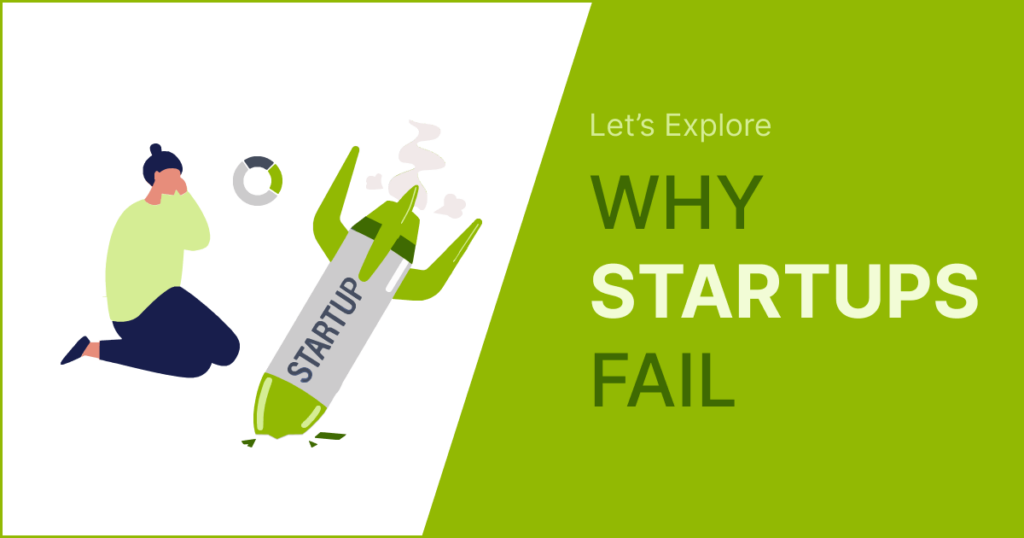The rate of registered startups is growing every year but do you know the bitter truth is that over 90% of startups fail? Why do startups fail? Well, there are plenty of reasons for this imminent failure across various industries.
In this article, we will cover in detail what leads to startup failure and how new businesses can try to overcome these challenges.
What has been happening in the Startup World Recently?
Recent trends in the startup world show a significant increase in funding in renewable energy and AI sectors. The UAE is set to raise $5.9 billion for renewable energy startups by 2024 primarily on solar, wind, and energy storage technologies.
On the other side, the UK’s AI startups are showings signs to break records this year even after imminent regulations. However many startups around the world are also facing huge challenges due to unsustainable business models and economic factors. This leads to a high failure rate among venture-backed companies.
10 Common Reasons for Startup Failure
Running a startup is a tough road and CEOs who depend on debt financing or venture capitalism have higher stakes at risk. Before launching your business, you must keep in mind how you will address those common issues that cause startup failure. So, let’s see why startup companies fail:
1) Financial Issues
It all starts the moment when startup founders do not create comprehensive financial plans without proper forecasting and budgeting. When you don’t get a clear understanding of your expenses and how you’ll generate enough revenue to compensate them, you end up overspending or fail to allocate resources properly.
Remember that cash flow is the lifeblood of any startup. Where expenses exceed income, it quickly depletes a startup’s funds. This issue is common is many startups and usually arises from:
- delayed invoicing
- slow customer payments
- unforeseen expenses.
Risks in Financial Fundings
While there are several ways of funding a startup, most of them have high risks involved. Here are a few examples:
- Equity Funding: While this method provides essential funds, it dilutes ownership and control. Investors expect high returns, which forces startups to scale rapidly but leads to unsustainable growth and failure.
- Debt Financing: This creates a fixed financial obligation regardless of business performance. High debt levels can lead to cash flow problems and financial strain.
- Crowdfunding: While it can generate funds and validate market interest, failing to meet campaign targets can damage your market reputation. Also, managing several small investors can be challenging as each has its expectations.
2) Running Out of Funds
Startups often run out of funds due to multiple factors, such as:
- underestimating expenses
- overestimating revenue
- poor cash flow management.
These issues can result from an initial lack of financial planning or rapid scaling without sufficient financial backing. For example, if a startup allocates a significant portion of its budget to marketing and product development in the initial stages of its life, it puts the whole financing at risk. In such cases, sales do not meet projections which leads to a huge financial strain on operations and causes a startup to run out of funds.
Example
Consider the case of Juicero, a startup that sold fruit and vegetable juicers with the integration of new technology. The company raised over $120 million but failed due to high product costs and lack of market demand. The company was closed in 2017 as it ran out of funds and all its operations were halted.
3) Pandemic and Supply Chain Disruptions
The recent shocker to supply chain disruptions was the COVID-19 pandemic whose implications are still causing businesses to fail. The COVID-19 pandemic caused unexpected disruptions across industries which mostly impacted startups or trade businesses.
The pandemic led to lockdowns, which reduced consumer spending and forced many businesses to change their operations. Since startups usually operate on thin margins, they face severe revenue declines as customer demand increases. Also, shifting to remote work created logistical challenges that decreased productivity and operational efficiency.
Startups reliant on just-in-time inventory faced delays and increased costs as raw materials and components became scarce. Due to all this hiatus many startups, especially those in early stages, lacked the financial resilience to withstand reduced cash flows. So, such unexpected events that cause supply chain disruptions are one of the biggest reasons why startups fail.
4) Failure to Address Market Need
Startups also fail because they create products or services that do not solve real problems for their target audience. This problem usually occurs when you jump into the business world without extensive market research. The key to understanding a customer’s need and behavior is to make a comprehensive market research plan.
Without the knowledge of your customer’s demand, if you invest heavily in the product—it will fail eventually and many startups have fallen victim to this. Failing to address market need results in poor sales and revenue so startups are unable to sustain operations.
Without customer adoption, even the most innovative products can fail. This also affects investor confidence which itself is a huge problem because it leads to a vicious cycle of declining resources and eventual closure.
5) Disharmony Among Team
Running a successful startup is not one man’s job. Every founder needs equally able partners and founding members who can support each other with all their hearts to maintain business growth. Disharmony among team members can be a huge problem and cause startup failure.
It all starts from the lack of cohesion and internal conflict due to poor communication and decreased productivity. When team members are not aligned on goals and vision, it creates inefficiencies and hurdles decision-making processes. Another thing is a toxic work environment that causes high employee turnover, disrupting continuity and increasing recruitment costs.
So, the moral is that successful startups thrive on collaboration, shared vision, and mutual respect. With these characteristics, any company can face the hurdles of early-stage business development.
6) Pricing or Costing Issues
Pricing and costing issues are your enemies that attack the whole system of your business. Setting prices too high can cause potential customers to turn towards cheaper alternatives. On the other hand, prices that are too low can harm profit margins and fail to cover operating costs.
Startups usually struggle to find the right balance between price and cost, especially in competitive markets. And also, underestimating costs can lead to financial strain as unexpected expenses arise.
So how to solve this issue? The short answer is that effective pricing strategies require thorough market research and, an understanding of customer value perception. Remember that careful cost analysis ensures profitability and sustainability so for that you need to hire experienced and smart financial managers.
7) Overestimating Demand
Some startups overestimate the demand for their products based on initial enthusiasm or niche interest. In such cases, they fail to validate their assumptions with broader market research. This results in an overproduction of goods or high investment in marketing and infrastructure. Their business model becomes unsustainable if the expected customer base does not materialize.
8) Working on the Wrong Product
Working on the wrong product means developing a product or service that does not work for your intended market. This misalignment results when startups invest resources into solutions that lack demand.
For example, a startup might create a technically impressive but it will fail if its not user-friendly or attractive. This causes low sales, wasted resources, and ultimately, failure.
9) Time Management Issues
The saying that “time is money” is literally true in startup world. Why? Because every minute that you waste on sitting idle and avoiding your business problems or delaying your production causes your resources to deplete.
Ineffective project management leads to inefficient time allocation that delays product development. The result of this is missed market opportunities and competitive disadvantages. When startups fail to prioritize tasks as per their urgency, Poor time management also causes burnout among team members which becomes a strain on their productivity and morale.
10) Failure of Product Design
The last culprit of startup failure on this list is failing to make an appealing and feedback-oriented product design. In IT startups, product design failure is one of the biggest issues that can lead to total business failure. Poor product design includes several problems, such as:
- inadequate user experience (UX)
- lack of essential features
- technical inefficiencies.
When a product is difficult to use, unreliable, or doesn’t meet the users’ needs, it fails to gain traction in the market. For example, if an app is not innovative and crashes frequently, users will abandon it whether or not it solves their problem. Then, these unsatisfied users give you negative reviews so their word of mouth leads to poor adoption rates.
Examples of Biggest Startup Failures
Let’s learn from the mistakes of the two biggest startup failures and find out why startups fail:
Quibi
Quibi was a short-form video streaming platform founded by Jeffrey Katzenberg and Meg Whitman in April 2020. Despite raising $1.75 billion, Quibi failed due to several factors, such as:
- unclear value proposition
- high subscription costs
- continuously changing consumer trends during the COVID-19 pandemic.
Another failure factor was their content which didn’t attract and retain a huge user base. Unfortunately, the company shut down just six months after its launch in October 2020.
Argo AI
Argo AI was an autonomous vehicle technology startup backed by Ford and Volkswagen that ceased its operations in 2022. Despite significant investments and technological advancements, Argo AI faced challenges in achieving commercial viability and scalability.
The high costs of developing self-driving technology and the long delays in regulatory approvals were the reasons behind its downfall. Ford and Volkswagen eventually decided to redirect their focus and resources to other areas of their autonomous vehicle strategies, putting an end to Argo AI.
Conclusion
While there are several other reasons for startup failures, the conclusion to why startups fail is improper planning and unpreparedness. As a business owner, you should be always on your toes to foresee how you will tackle any challenge that your business has to face,
If you are lucky enough to gather the right cooperative team who can handle your finances, product demand, and market research, then all is set for you. The best way to sustain your startup amid turmoil is by focusing on business intelligence. Get insights from data and make calculated decisions without putting all your eggs into one basket. That’s how you’ll ace the startup race!
FAQs
Q. What is the biggest reason for startups to fail?
The biggest reason for startups to fail is running out of funds, as there is almost no escape for startups to recover from this situation.
Q. Which startups failed in their first year?
Startups like Juicero and Quibi failed within their first year due to a lack of market need and high costs.
Q. Are generative AI startups getting successful?
Yes, generative AI startups are seeing increasing success due to advancements in AI technology and growing market demand.
Q. Who should be a startup CEO?
A startup CEO should be a visionary leader with strong business knowledge, resilience, and the ability to drive the company towards its goals.








